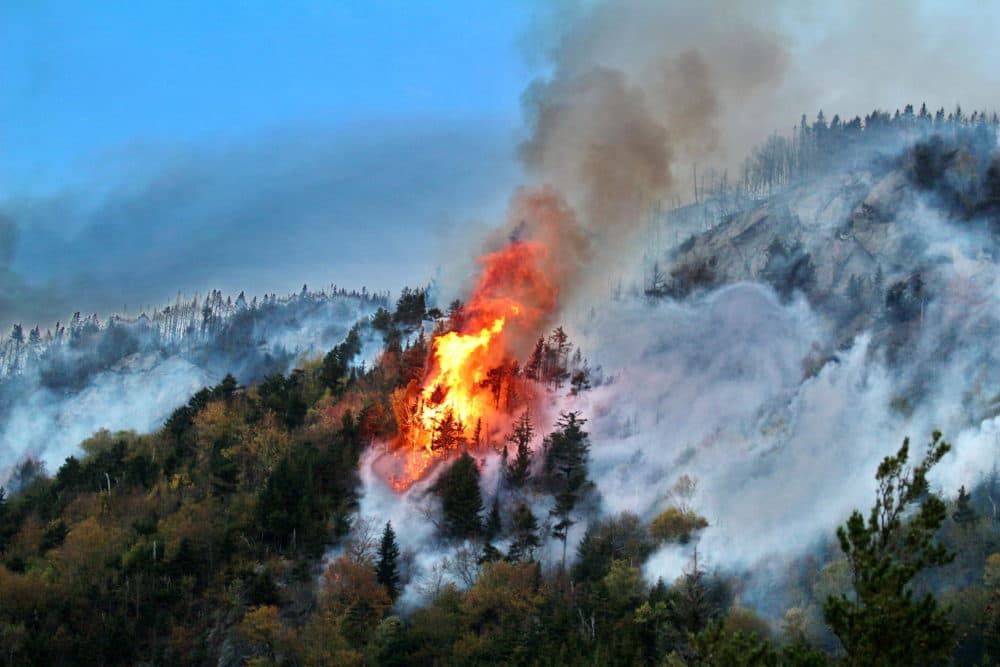Advertisement
‘It Can Happen Here’: N.H. Faces High Wildfire Risk Amid Climate Catastrophe In West

As millions of acres burn in California and Oregon, officials in New Hampshire say this region is also facing a high risk of wildfires, amid drought and the arrival of cool, dry fall weather.
The National Weather Service says low humidity, “dry fuels” and gusty winds will elevate fire risk Monday in New Hampshire as well as in Maine.
“Conditions are ripe for us to potentially see a lot of wildland fire ignition if people are not careful,” says forest ranger captain Douglas Miner with the state Division of Forests and Lands.
Climate change has caused average temperatures to increase in New Hampshire over the past several decades. It’s also causing more precipitation — but in heavier, more sporadic bouts and with long dry spells in between rainfalls.
That combined with a lower winter snowpack leads to summer drought conditions. This year's drought is forecast to continue in the coming weeks. It began in May and is now severe in southeastern and central New Hampshire.
Though only about 100 acres have burned in the state this season, including a patch in Hanover on Sunday that was ignited by a lightning strike, Miner says the worst could be yet to come.
“It really preps the fuels, under the conditions that we’ve seen this summer, to make the conditions more conducive for a small fire turning into a much larger fire,” Miner says.
Those fuels don’t just include dry brush and trees, but also leaf litter and dry topsoil. The drought has dried out these upper layers, Miner says, meaning fires can smolder and burn as much as one or two feet into the ground.
“These fires become much more labor-intensive,” he says. “We haven’t had a lot of acreage yet that you would expect during the drought conditions, but most of the fires we have had actually have burned much deeper into the duff layer.”
He says firefighters have to dig the burning material out by hand and mix it with water or fire suppressant foam to put it out. The drought has also depleted many of the ponds and other surface water sources from which crews would normally pump to fight fires in remote areas.
The public is strongly discouraged from any open burning during conditions like this. Miner says even permitted campfires or brush pile burns can spread if they’re not properly extinguished by being thoroughly soaked and mixed with water.
These fires and lightning strikes can leave embers to smolder in the ground for long periods. All in all, Miner says about nine in 10 forest fires in New Hampshire are caused by humans.
“Once we get into windy conditions like we have today [Monday]… that’s going to fan the flames and liven up any ground fire or duff fire and cause it to become a surface fire,” he says. “Then you’re talking a lot more difficulty and a lot more acres involved in trying to suppress something like that.”
Miner says New Hampshire has different fuels and less of an annual fire season than states like California, which is currently enduring another record year of deadly, destructive fires fueled in part by climate change.
But Miner says the Northeast does “have a fire-prone history” – meaning it’s on residents to follow state recommendations to prevent fires from spreading.
“Anyone that has had a fire and had it impact their home, which we have had some of those in New Hampshire, will speak to the fact that it is very important, and that it can happen here,” Miner says.
On average, the state sees 175 wildfires a year covering 225 acres total, according to the draft Forest Action Plan for the coming decade.
One of New Hampshire’s largest fires in recent memory, the 2017 Dilly Cliff Fire in North Woodstock, was caused by humans and burned over 75 acres for more than a month, temporarily closing parts of the Appalachian Trail and other popular recreational areas.
That fire and two others that covered hundreds of acres in 2015 and 2016 were the state's largest in recent memory. New Hampshire also had a severe drought stretch into 2017 from 2016 – the hottest year ever recorded on Earth.
This story is a production of New England News Collaborative. It was originally published by New Hampshire Public Radio on Sept. 14, 2020.